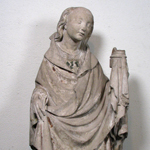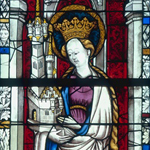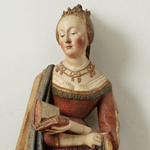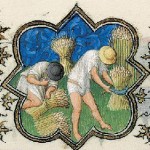Posts Tagged ‘barley’
Friday, July 8, 2011

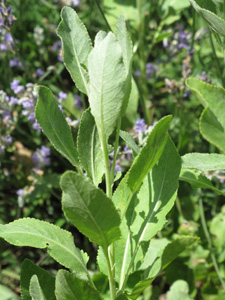
Hops (Humulus lupulus), considered today to be crucial to beer brewing, were not commonly used until the fifteenth century. Before that time, brewers added different herbs, such as??alecost??(Tanacetum balsamita), to their beer to improve its flavor. Several of these medieval brewing herbs can be found in Bonnefont garden.
Ale is made of malte and water; and they the which do put any other thynge to ale then is rehersed, except yest, barme, or godesgood, doth sofystical theyr ale.
???Andrew Borde, The fyrst boke of the introduction of knowledge, 1452
Beer was a staple drink for medieval Europeans, as it provided much-needed calories to the often undernourished population and was cleaner and safer to drink than water. Then, as now,??beer was made by brewing malted barley in boiling water to make sugars more available for yeasts to consume (see an image of Jorg Prewmaister tending his brew in a page from a fifteenth-century German manuscript, Amb. 317.2). This sugary, malty potion, known as “wort,” eventually becomes beer after the yeasts eat the sugars, releasing carbon dioxide and alcohol as byproducts of fermentation. On its own, wort is fairly flat in flavor, so brewers add additional ingredients, such as hops and spices, to enliven a beer’s taste.
Read more »
Tags: Achillea millefolium, Add new tag, ale, alecost, barley, beer, brew, bryan_stevenson, costmary, Glechoma hederacea, ground ivy, gruit, hops, humulus lupulus, Ledum palustre, malt, Myrica gale, Reinheitsgebot, stinging nettle, sweet gale, Tanacetum balsamita, Urtica dioica, wild rosemary, wort, yarrow
Posted in Botany for Gardeners, Food and Beverage Plants, Fragrant Plants, Medicinal Plants | Comments (3)
Friday, March 11, 2011
At certain times of the year in the medieval rural landscape, it would have been common to see plump sheaves of grain standing in sunny fields like so many golden tokens of agricultural wealth and prosperity, as numerous depictions???even in some of the most sumptuous manuscripts of the Middle Ages, such as the Belles Heures of the duke of Berry???attest. At harvest, the wheat was cut at the base of the stalk with a sickle and then gathered up in large armfuls and tied about the middle. The resulting bundles were left spaced and standing upright in the fields, which allowed them to dry even if it happened to rain before they could carted off for threshing.
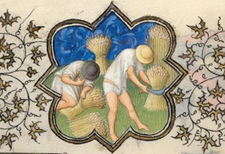

Details of illuminations from Folio 8r and Folio 9r from the Belles Heures of Jean de France, duc de Berry, 1405???1408/9.
Read more »
Tags: barley, Belles Heures, blazon, Bolton, caraway, carrot, Cheshire, Comyn, cumin, Cuminum cyminum, garb, Geoffrey Chaucer, gold, grain, Grosvenor, heraldic, heraldry, John of Gaunt, oat, Owain Glynd??r, parsley, rye, Scrope, sheaf, sheaves, shield, wheat
Posted in Plants in Medieval Art | Comments (1)
Friday, December 3, 2010
Above, from left to right: Saint Barbara (detail), mid-15th century, French, Gift of Mr. Edward G. Sparrow, 1950 (50.159); Detail of Saint Barbara from The Virgin Mary and Five Standing Saints above Predella Panels, 1440???46, The Cloisters Collection, 1937 (37.52.1); Saint Barbara (detail), ca. 1490, German, The Cloisters Collection, 1955 (55.166).
Although Saint Barbara is not mentioned in early martyrologies, hagiographies place the early Christian virgin and martyr in the third century A.D. According to The Golden Legend, a popular collection of saints’ lives dating to the thirteenth century, she was martyred on the fifth of December, during the reign of Emperor Maximianus and under the orders of Martianus, the prefect of her city of Heliopolis, in??Phoenicia. Veneration of Saint Barbara was common in both the eastern and western churches by the ninth century, and she remains a popular saint to this day, although her feast is widely celebrated on the fourth rather than the fifth of December. Read more »
Tags: Adonis, anise, Anthesteria, Barbarazweig, Barbarea, Barbarea vulgaris, barley, Eleusinian Mysteries, kykeon, Martianus, Maximianus, pomegranate, Provence, raisin, Saint Barbara, The Golden Legend, wheat, winter cress, yellow rocket
Posted in Food and Beverage Plants, The Medieval Calendar | Comments (4)
Monday, July 6, 2009
Above, from left to right: Calendar page for July from the Belles Heures of Jean de France, Duc de Berry, 1405???1408/1409. Pol, Jean, and Herman de Limbourg (Franco-Netherlandish, active in France, by 1399???1416). French; Made in Paris. The Metropolitan Museum of Art, New York, The Cloisters Collection, 1954 (54.1.1); detail of the activity for the month; detail of the zodiacal symbol Leo. See the Collection Database to learn more about this work of art.
???No tempest, good Julie,??? said Thomas Tusser. In Tusser???s sixteenth-century English, “July” rhymed with “truly”???as it did until the mid-eighteenth century. (The Oxford Companion to the Year, 1999). If the midsummer storms did not spoil the crops, the farmer could count himself lucky. (For charms against bad weather, see “Midsomer Magick,” June 23.)
The great event of the medieval summer was the harvest. A poor yield meant privation for the whole cycle of the year to come. By July the grain stores of the last harvest were depleted. In the great fourteenth-century poem Piers Plowman, Piers speaks of staving off hunger with a vegetable diet of parsley, leeks, and cabbages, supplemented with a little cream and some cheese, until the grain in his barn can be replenished at Lammas, the first of August. Read more »
Tags: barley, grain, harvest, hordeum vulgare, Hrabanus Maurus, July, legume, rye, secale cereale, Thomas Tusser, triticum sp., wheat
Posted in Food and Beverage Plants, The Medieval Calendar | Comments (0)





